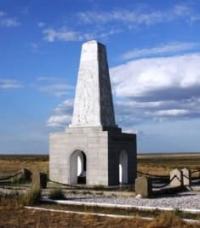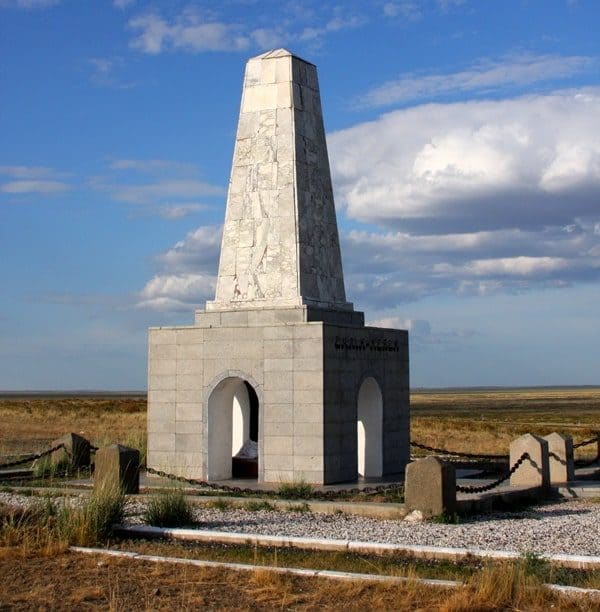Вы здесь
Monument of Enlik and Kebek.


Adventure holiday in Altai mountains Kazakhstan.
“...it seemed a part of her life, to step from the ancient to the modern, back and forth. She felt rather sorry for those who knew only one and not the other. It was better, she thought, to be able to select from the whole menu of human achievements than to be bound within one narrow range”
Orson Scott Card.
Recreational park in Ust-Kamenogorsk.
The Enlik and Kebek mausoleum is located on a small hill 464 meters above sea level, 95 kilometers northwest of the Chingiztau ridge, 126 kilometers southeast of the city of Semey, 101 kilometers west and slightly north of the city of Ayagoz, in 61 kilometers to the north-west from the district center of the Abai district of the village of Karaul, in the Abai region.
Even from a distance, a pyramidal obelisk is visible, installed on a massive tent-shaped foundation, which is located next to the Semey-Karaul highway, 128 kilometers from Semey. Inside the mausoleum there are two graves, on them there is a slab with inscriptions: “Enlik – Kebek.
In the poem "Enlik-Kebek" events develop against the background of the enmity of two clans (Naiman-Tobykty), to which the characters belong. In one of the clans of Tobykta lived a young batyr Kebek. In Shakarim's poem, Kebek is characterized as a favorite of the family, from the age of fifteen he distinguished himself by his strength, thirst for life and exploits, "a soul with fire", "brunette, medium height, broad-shouldered, good-natured, courteous."
Since the poem "Enlik-Kebek" has not yet been translated into Russian, it is difficult to analyze its ideological and artistic merits. Kebek decided to go to Nysan, who was famous at that time and lived in the Shyngystau mountains, in order to find out his fate.
Kebek, quietly approaching the wretched yurt of Nysan-Abyz, which stood alone in the rocks of Shyngys, stopped, as if spellbound, sad, soul-touching sounds came from the yurt. In describing the sounds of music, playing the kobyz, their actions on a person, such epithets as “magic music”, “enchanting sounds”, “wonderful sounds caressing the ear” overwhelmed the soul with some unknown feeling, which became painfully creepy, hard, but I wanted to listen to this magical music again and again, without stopping.
I wanted these enchanting sounds not to be interrupted for a long, long time, they said a lot to the soul and heart of Kebek. Nysanabyz predicts to Kebek that in a few years he will die in the color of his years and strength, scolded by his relatives and enemies because of the girl “tall, slender, like a gazelle, her hair is black like a raven’s wing, her forehead is high, her eyes are like a dark autumn night and deep as the bottom of the sea."
A lot of time passes. One day, to have fun, Kebek goes hunting for foxes with a golden eagle. For a long time he scoured the hills and valleys, the day was fading into evening, it was a long way to go home, the auls were not visible nearby.
Having left for the hill, Kebek saw in one of the gorges of Shyngys, not far from Mount Khan, a thin ribbon of curling smoke. He went to him, confident that he would find an aul there, a shelter for the night. In this small village, Kebek was struck by the beauty of a wonderful girl named Enlik.
They fell in love with each other. Enlik was previously betrothed by her parents to a rich and elderly Kazakh of the Kerey family, more than half of the bride price was paid for her. She needed to either overcome love in herself, or, violating the custom of antiquity, unite with her beloved, dooming herself to revenge and deprivation.
Breaking the custom, the young lovers fled one of the dark nights. They had a son. But happiness did not last long. Rod Enlik, considering the escape of the girl an insult, began to take revenge on the family of Kebek.
Mutual litigation, barymta (cattle rustling), often ending in murders, became more frequent. Finally, the parties turned to the mediation of biys. The cruel biy Kengirbai was for the punishment of Kebek and Enlik who violated the custom. And the prediction of Nysan-Abyz came true, a bloody deed was accomplished - the execution.
lasso was thrown around the neck of the bound Kebek and Enlik, before her death, Enlik addressed the two families with a farewell word. She does not ask for mercy, does not beg to let them live, with dignity asks for an opportunity to say goodbye to her love, to her husband Kebek, to bury them together in one grave, to have pity on an innocent four-month-old son.
Her last parting word, expressing the human right to life and love, challenges the bearers of cruel, inhuman morals. They were tied to the tail of a horse, and after a few minutes the disfigured corpses were thrown into a previously prepared pit.
No one picked up the little executed. The author sought to raise his voice against injustice and cruelty. Despite the fact that not everything in the poem is perfect, it was a great success for the author, because the harmony of the composition, the figurativeness of the language, the novelty of the interpretation of the characters of the main characters made a certain role in the development of this genre.
The people kept in their memory the images of Enlik and Kebek, a grave was preserved on the hill called “Enlik-Kebek”, a monument was erected nearby as a symbol of love, many songs and legends were composed about them.
Behind the dry lines of the museum text, there is a story about the great tragic love of the Kazakh girl Enlik and the horseman Kebek, described in his time by Abai. Once Abai's ancestor Kengirbay, arranging a lawsuit about a bride, sentenced to death both the bride and the violator of free collusion - Enlik and Kebek.
The monument was erected in 1960 by local youth as a tribute to the legendary couple of lovers, as a symbol of true love. In 1976, at the request of the inhabitants of this area, the entire mausoleum was covered with white marble.
Red, burgundy and light gray granites were used in the construction, chains were installed. The monument is a tower 6 meters high, with a dome, arches decorated with oriental ornaments are installed on four sides. On the facade of the monument there is an inscription: "Enlik - Kebek".
This is a love story. A strict and majestic monument to lovers - Enlik and Kebek - still challenges the tragic fate, proving the power of Love in the Middle Ages, the Shyngystau mountains are the birthplace of the Great Abai.
Family strife for the best lands. Two clans of Matai and Tobykty howling among themselves. Cupid's arrow knows no barriers, and it so happened that HE is from the Argyn clan, fell in love with HER from the Naiman clan.
It so happened that Kebek ended up with enemies for the winter and fell in love with Enlik. But everyone was against their love, as well as two warring families who supposedly marry their children, but this was not to be.
For the first time, a poem called "The Word, preserved in the memory of the Kazakhs" was published in the newspaper "Dala ualayaty" (No. 31 - 39) in 1892. In this version, the events of the poem are covered from a popular point of view, it is distinguished by sympathy for lovers and hatred for their persecutors.
Despite some shortcomings in composition, language and style, the poem is valuable for the authenticity and typicality of the conflict depicted in it. In 1900, in No. 46 of the Dala ualayaty newspaper, another version of the poem was published under the title "History of the life of the Kazakhs", which retains the original storyline, but the characters have different names.
Magaui Kunanbaev's poem is interesting for its social sharpness, satirical depiction of the court of biys, which is close to the first version in terms of plot and composition. In 1960, it was published in the collection "Poems" in Alma-Ata.
In 1912, Shakarim Kudaiberdiev's poem "Unfair Punishment" was published in Semipalatinsk, in which the author gave his interpretation of the main theme of the poem "Enlik - Kebek", emphasizing the historical authenticity of the events described, which he attributed to 1780.
In 1917, M. O. Auezov wrote the tragedy "Enlik - Kebek", which has not left the stages of Kazakh drama theaters for many decades. The tragedy consists of four acts, five actions. For the first time, the tragedy "Enlik - Kebek" was staged in the village of Abay in 1917, the author himself acted as the director and prompter of this production.
In 1923, 1943 and 1956 the play was revised several times. If in the first versions the author criticized the inter-clan strife, later the play exposed the entire feudal-hierarchical system and acquired a high civic pathos.
In 1924, members of the Central Club of the KASSR of the All-Russian Union of Communist Youth staged the second version of the play. K. Ernazarova (Enlik), J. Sarsenbin (Kebek), R. Asylbekov (Yesen), J. Auezov (Karamande), S. Mukanov (Kubey), S. Baigozhin (Espembet), E. Umurzakov ( Japal) and others. In 1926, the Kazakh Drama Theater (director S. Kozhamkulov) opened with the play "Enlik - Kebek". After the staging in 1933 by director M. G. Nasonov of the next version, “Enlik - Kebek” was staged in Semipalatinsk (1935, director O. Bukeev), Chimkent (1939, director Kh. Shazhenov) and other regional theaters in Kazakh, Russian , Korean.
The third version of the play was staged on the stage of the Kazakh Drama Theater in 1957 and was highly appreciated at the Decade of Kazakh Literature and Art in Moscow in 1958.
This is how the writer Mukhtar Auezov describes the grave of Kengirbai in the second volume of the novel "The Way of Abai".
“Winter twilight slowly descended on the steppe. Covered with snow, it did not darken, but gradually became more and more blue. Silent cold emanated from her. In the muddy-blue expanse, a tall, gloomy mazar soon became visible. For a hundred years, its powerful pointed cone has been towering over the entire district, there are no cracks or fallen stones in it.
And just as dominating ignorant descendants of Kengirbai, his gloomy spirit, and his grave reigns over the steppe, frozen in centuries-old immobility, deaf to the whole world. There is the silence of eternal night, persistent darkness, fenced off by thick walls from the light of the sun, from the living voices of life.
It seems that the very time has frozen, that the laws of the steppe are as eternal and unchanging as the motionless darkness of the grave."
Geographical coordinates of mausoleum of Enlik and Kebek: N49°20'35.28" E79°50'19.68"


Authority:
"Monuments to Central Asia". Author M. Hashimov. Saga publishing house, 2001. Novel "Way of Abay", Mukhtar Auezov.
Photos by
Alexander Petrov.







